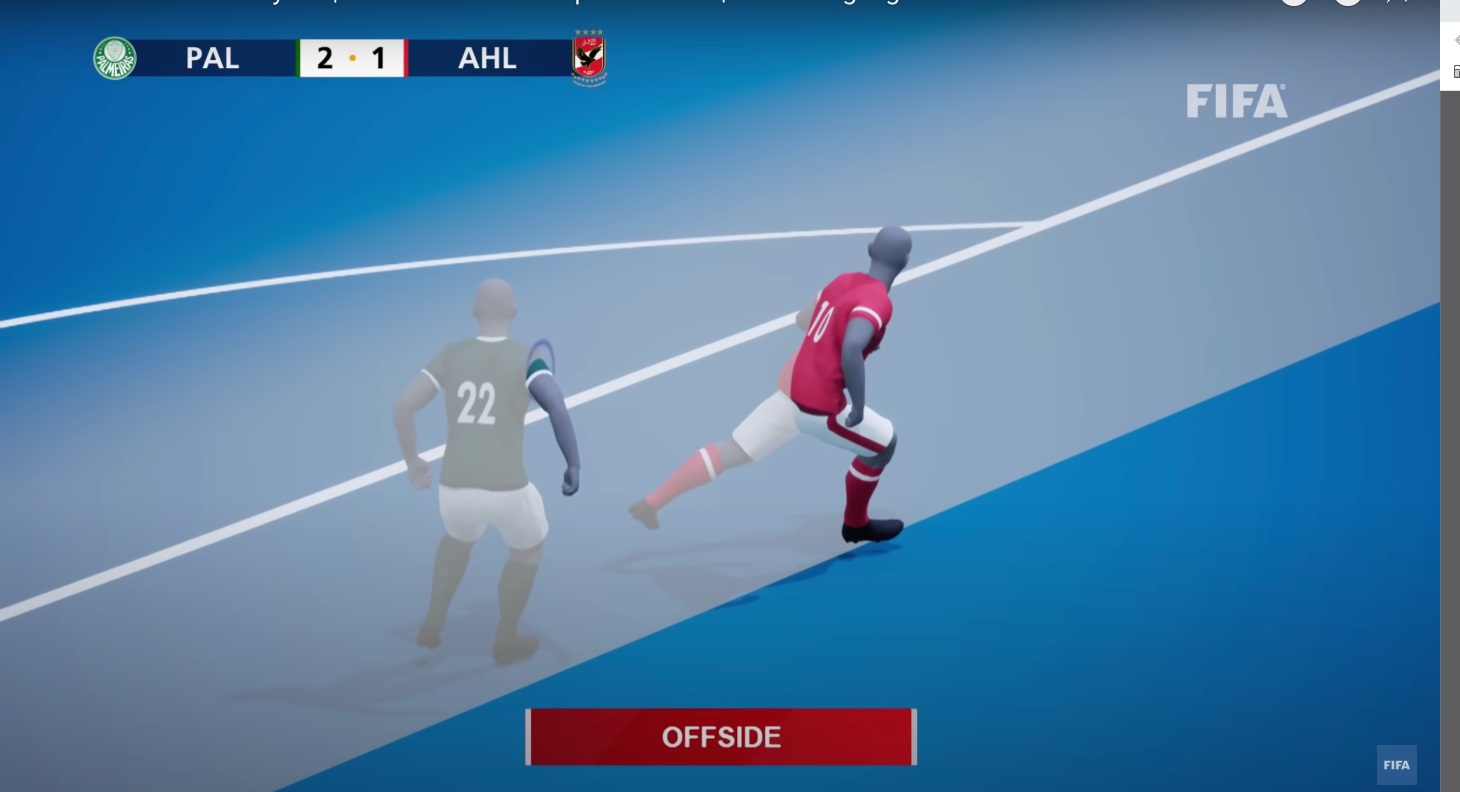Sports
Qatar 2022: FIFA to Use Semi-Automated Offside Technology

By Adedapo Adesanya
The Federation of International Football Association (FIFA) has announced that semi-automated offside technology will be used at the FIFA World Cup 2022 in Qatar.
The new technology will offer a support tool for the video match officials and the on-field officials to help them make faster, more accurate and more reproducible offside decisions on the biggest stage of all.
Following the successful use of VAR technology at the 2018 FIFA World Cup in Russia, FIFA President, Mr Gianni Infantino, declared in The Vision 2020-23 that FIFA would strive to harness the full potential of technology in football and further enhance VAR.
By working with Adidas and various partners, and especially with the Working Group for Innovation Excellence and technology providers, FIFA has spent the last few years further improving the VAR system, including the use of semi-automated offside technology.
How Does It Work?
The new technology uses 12 dedicated tracking cameras mounted underneath the roof of the stadium to track the ball and up to 29 data points of each individual player, 50 times per second, calculating their exact position on the pitch. The 29 collected data points include all limbs and extremities that are relevant for making offside calls.
Al Rihla, the official match ball for the tournament, will provide a further vital element for the detection of tight offside incidents as an inertial measurement unit (IMU) sensor will be placed inside the ball. This sensor, positioned in the centre of the ball, sends ball data to the video operation room 500 times per second, allowing a very precise detection of the kick point.
By combining the limb- and ball-tracking data and applying artificial intelligence, the new technology provides an automated offside alert to the video match officials inside the video operation room whenever the ball is received by an attacker who was in an offside position at the moment the ball was played by a teammate. Before informing the on-field referee, the video match officials validate the proposed decision by manually checking the automatically selected kick point and the automatically created offside line, which is based on the calculated positions of the players’ limbs. This process happens within a few seconds and means that offside decisions can be made faster and more accurately.
After the decision has been confirmed by the video match officials and the referee on the pitch, the exact same positional data points that were used to make the decision are then generated into a 3D animation that perfectly details the position of the players’ limbs at the moment the ball was played. This 3D animation, which will always show the best possible perspectives for an offside situation, will then be shown on the giant screens in the stadium and will also be made available to FIFA’s broadcast partners to inform all spectators in the clearest possible way.
The workflow of semi-automated offside technology and the connected ball technology have been successfully trialled at numerous test events and live at FIFA tournaments, including the FIFA Arab Cup 2021 and the FIFA Club World Cup 2021.
During these matches, the new technology was able to support the video match officials by helping them to make more accurate and more reproducible offside decisions in a shorter period of time.
The data collected during online and offline tests has been analysed and validated by the MIT Sports Lab, with TRACK at Victoria University scientifically validating the limb-tracking technology. Further insights into the technological capabilities of such multi-camera tracking systems are being provided by a research team at ETH Zurich.
More tests will be conducted in the coming months to fine-tune the system before a global standard is implemented to ensure that the new technology can be used in the world of football.
Speaking on the development, Mr Johannes Holzmüller, FIFA’s Director of Football Technology & Innovation said — “We will have the semi-automated offside set-up with 12 cameras and the official match ball with connected ball technology in all stadiums at the FIFA World Cup 2022. The new technology will provide video match officials with real-time offside alerts using artificial intelligence.
“As the video match officials will be quality-controlling these outputs, we still refer to the system as ‘semi-automated offside’ as the video match officials have to validate the proposed decision and then inform the on-field referee.
“By using the exact same data to create a 3D animation for in-stadium fans and TV viewers, fans will receive a quick and accurate visualisation of the offside situation. This process was developed with input from FIFA’s Fan Experience Panel.”
FIFA added that all details on the semi-automated offside technology set-up and the connected ball technology will be presented to the teams that have qualified for the FIFA World Cup 2022 at the Team Workshop in Doha, Qatar on July 4-5 and then shared with the public.
The FIFA World Cup will hold in Qatar from November 21.
Sports
BC.Game: A Rising Star in Nigeria’s Betting Scene

BC.Game has quickly gained traction in Nigeria as a prominent online betting platform, offering a unique blend of traditional and modern gaming experiences. Known for its user-friendly interface and innovative features, BC.Game caters to both seasoned bettors and newcomers alike. The platform provides a wide range of betting options, including sports betting, casino games, and its signature blockchain-based games, which set it apart from competitors.
One of BC.Game’s standout features is its commitment to transparency and fairness, leveraging blockchain technology to ensure secure and verifiable transactions. Nigerian users appreciate the platform’s support for local payment methods, making deposits and withdrawals seamless. Additionally, BC Game register offers enticing bonuses and promotions, further enhancing its appeal.
With a growing community of players and a reputation for reliability, BC.Game is carving out a niche in Nigeria’s competitive betting market, attracting users seeking a trustworthy and innovative gaming experience.
Exploring the BC.Game Official Website: Design and Navigation
The official website of BC.Game is a testament to modern web design, offering users in Nigeria a seamless and visually appealing experience. From the moment visitors land on the homepage, they are greeted with a sleek, intuitive layout that prioritizes functionality and user engagement.
The design is clean and vibrant, with a color scheme that reflects the brand’s dynamic personality. Key sections, such as sports betting, casino games, and promotions, are prominently displayed, ensuring users can quickly find what they’re looking for. The website is fully optimized for both desktop and mobile devices, allowing Nigerian players to enjoy a smooth experience regardless of their preferred platform.
Navigation is one of the website’s strongest points. A well-structured menu at the top of the page provides easy access to all major sections, including account management, game categories, and customer support. The search bar further enhances usability, enabling users to locate specific games or information in seconds. Additionally, the website supports multiple languages, including English, making it accessible to a diverse audience.
BC.Game’s website also emphasizes transparency and trust. Key information, such as terms and conditions, privacy policies, and responsible gaming guidelines, is readily available in the footer section. For new users, the registration process is straightforward, with clear instructions guiding them through account creation.
The platform’s design incorporates engaging visuals and animations without compromising loading speed, ensuring a fast and enjoyable experience. Promotions and bonuses are highlighted through eye-catching banners, keeping users informed about the latest offers.
BC.Game’s official website is a well-designed, user-centric platform that combines aesthetics with functionality. Its intuitive navigation, responsive design, and focus on user experience make it a standout choice for Nigerian players seeking a reliable and enjoyable online betting environment.
How to Register on BC.Game: A Step-by-Step Guide
Creating an account on BC.Game is a straightforward process, designed to get you started quickly and effortlessly. Follow these detailed steps to complete your registration:
- Visit the Official Website. Open your browser and go to the official BC.Game website.
- Locate the Registration Button. On the homepage, look for the “Sign Up” button, located at the top-right corner of the screen. Click on it to begin the process.
- Fill in Your Details. A registration form will appear. Enter your email address, create a strong password, and confirm it. Alternatively, you can use social media options for a quicker sign-up process.
- Accept the Terms and Conditions. Read through the terms and conditions, then check the box to confirm your agreement. This step is crucial to ensure you understand the platform’s policies.
- Log In and Start Playing. Log in using your credentials, and explore the platform. You can now deposit funds, claim bonuses, and start betting.
By following these steps, you’ll complete the BC Game register process in just a few minutes. The platform’s user-friendly design ensures a hassle-free experience, even for first-time users.
Bonuses and Promotions on BC.Game for Nigerian Users
BC.Game offers an impressive array of bonuses and promotions tailored to enhance the experience of Nigerian players. These rewards are designed to attract new users and keep existing players engaged, providing excellent value for money.
- Welcome Bonus. New users are greeted with a generous welcome package. Upon completing the registration and making their first deposit, players can receive up to 300% of their deposit amount as a bonus. For example, if a Nigerian user deposits ₦10,000, they could receive an additional ₦30,000, giving them a total of ₦40,000 to play with.
- Daily Lucky Spin. BC.Game features a daily lucky spin where users can win free crypto rewards. Prizes range from small amounts to significant jackpots, adding an element of excitement to the platform.
- Recharge Bonus. Regular players can benefit from recharge bonuses, which reward users for subsequent deposits. For instance, a second deposit come with a 100% bonus, while a third deposit could offer 50%. These bonuses ensure that loyal players are consistently rewarded.
- Task Hub Rewards. BC.Game includes a unique Task Hub where players can complete specific challenges to earn additional bonuses.
- VIP Program. High rollers and frequent players can join the VIP program, which offers exclusive perks such as higher withdrawal limits, personalized customer support, and special promotions. VIP members also enjoy cashback offers of up to 15% on losses.
With these bonuses and promotions, BC.Game ensures Nigerian users have plenty of opportunities to maximize their winnings and enjoy a rewarding betting experience. The platform’s transparent terms and clear reward structures make it a top choice for players seeking value and excitement.
BC.Game Sports Betting: A World of Options for Nigerian Players
The sports betting section on BC.Game is a hub of excitement, offering Nigerian players a comprehensive range of sports and betting options. Whether you’re a fan of football, basketball, tennis, or niche sports, BC.Game ensures there’s something for everyone. The platform covers a wide variety of sports, with football being the most popular choice among Nigerian users. Major leagues like the English Premier League, La Liga, and UEFA Champions League are well-represented, alongside local Nigerian leagues. Other sports, such as basketball, cricket, rugby, and even eSports, are also available, catering to diverse interests.
BC.Game provides multiple types of bets to suit different betting styles. Traditional options like match winner, over/under, and handicap betting are staples on the platform. For those seeking more dynamic options, live betting is a standout feature. This allows players to place bets in real-time as the action unfolds, adding an extra layer of thrill to the experience. Additionally, BC.Game offers special bets like player-specific outcomes (e.g., first goal scorer) and combination bets, which allow users to combine multiple selections into a single wager for higher potential payouts. The platform also supports accumulator bets, enabling players to bet on multiple matches or events simultaneously.
The user interface in the sports betting section is intuitive, with clear odds displayed for each event. Players can easily navigate between sports, leagues, and matches, making the betting process seamless. The inclusion of detailed statistics and live updates further enhances the experience, helping users make informed decisions. BC.Game’s sports betting section is a well-rounded offering that caters to both casual bettors and seasoned punters.
BC.Game Online Casino: A Thrilling Gaming Experience for Nigerian Players
The online casino section of BC.Game is a vibrant and diverse space, offering Nigerian players an unparalleled gaming experience. With a vast selection of games, cutting-edge technology, and a focus on entertainment, this section is a haven for casino enthusiasts. BC.Game’s casino features a wide variety of games, catering to all preferences. Slot games are a major highlight, with hundreds of titles available. From classic three-reel slots to modern video slots with immersive themes and bonus features, there’s something for every type of player. Popular titles from leading providers ensure high-quality graphics, smooth gameplay, and fair outcomes.
For fans of table games, BC.Game offers all the classics, including blackjack, roulette, baccarat, and poker. These games come in multiple variations, allowing players to explore different rules and strategies. The platform also features live dealer games, where players can interact with professional dealers in real-time, creating an authentic casino atmosphere from the comfort of their homes. In addition to traditional casino games, BC.Game stands out with its unique blockchain-based games. These include provably fair games like Crash, Plinko, and Dice, which leverage blockchain technology to ensure transparency and fairness. These games are simple yet highly engaging, making them a favorite among crypto-savvy players.
The casino section is designed with user convenience in mind. Games are categorized for easy navigation, and players can use filters to find their favorites quickly. The platform also supports demo modes for many games, allowing users to practice before wagering real money. BC.Game’s online casino is a dynamic and entertaining space that offers Nigerian players a wide range of games, from traditional favorites to innovative blockchain-based options. With its user-friendly design and diverse offerings, it’s a top destination for online casino enthusiasts.
BC.Game Casino: Top Games from Leading Providers
BC.Game collaborates with some of the most renowned game providers in the industry, ensuring Nigerian players have access to a premium selection of games. These partnerships guarantee high-quality graphics, engaging gameplay, and fair outcomes across the platform.
The casino features games from leading providers like Pragmatic Play, Evolution Gaming, NetEnt, and Play’n GO, among others. Slot enthusiasts can enjoy popular titles such as Sweet Bonanza, Starburst, and Book of Dead, each offering unique themes and exciting bonus features. For table game lovers, providers like Evolution Gaming deliver immersive live dealer experiences, including blackjack, roulette, and baccarat. These games are streamed in high definition, offering real-time interaction with professional dealers.
BC.Game also includes innovative blockchain-based games developed in-house, such as Crash, Dice, and Plinko, which are provably fair and highly engaging. With such a diverse range of games from top providers, BC.Game ensures a world-class casino experience for Nigerian players.
BC.Game Support Service: Reliable Assistance for Nigerian Players
BC.Game offers a dedicated support service to ensure Nigerian players have a smooth and enjoyable experience on the platform. The support team is available 24/7, ready to assist with any queries or issues, from account setup to payment concerns. Players can contact the support team through multiple methods:
- Live Chat: The fastest and most convenient option, live chat connects users directly with a support agent. Accessible via the website, it provides real-time assistance for urgent matters.
- Email Support: For detailed inquiries or issues requiring documentation, players can reach out via email. The team typically responds within a few hours.
- Help Center: BC.Game also features a comprehensive FAQ section, covering common questions about registration, payments, and gameplay.
With its responsive and professional support service, BC.Game ensures Nigerian players receive timely and effective assistance whenever needed.
Sports
Exploring the Features of Wasafi Bet Bookmaker

Wasafi Bet is a rapidly growing bookmaker in Tanzania that has gained tremendous popularity thanks to its user-friendly design, reliable services, and diverse betting opportunities. It offers a range of features tailored to meet the preferences of both novice and professional bettors alike. From its intuitive interface to the convenience of its mobile application, Wasafi Bet stands out as a leading choice for sports and online casino enthusiasts in Tanzania.
An Overview of the User Interface
The Wasafi Bet website is designed with simplicity and efficiency in mind, making navigation straightforward for all users. All essential categories, such as “Sports Betting” and “Online Casino,” are prominently displayed on the homepage, ensuring quick access to your preferred activity. Functional buttons, including account management, current promotions, and transaction options, are strategically located at the top of the screen. This organisation ensures that users can effortlessly find what they are looking for without unnecessary complexity. Additionally, the overall layout employs an appealing design with clear fonts and vibrant accents, enhancing the user experience.
Details About the Mobile Application
The Wasafi Bet mobile application is another commendable feature, allowing bettors to place wagers from anywhere. With a download size of approximately 20 megabytes, the app is lightweight and does not consume excessive storage. It retains all the website’s core functionalities, including access to sports betting, casino games, and account management. Importantly, users can only download the Wasafi Bet mobile application from the official website, ensuring the app’s authenticity and security. The app’s responsiveness and optimised performance make it a practical choice for users on the go.
Fast and Reliable Transactions with Multiple Options
Wasafi Bet ensures seamless and secure transactions, making deposits and withdrawals simple and hassle-free. The platform supports a variety of payment methods, including mobile money services such as M-Pesa and Tigo Pesa, which are highly prevalent in Tanzania. Users can begin betting with a minimum deposit of 1,000 Tanzanian Shillings, making the platform accessible to a wide audience. Additionally, transactions are processed quickly, allowing bettors to focus on enjoying their experience without unnecessary delays.
Technical Support and Platform Reliability
Wasafi Bet is committed to offering dependable customer support to resolve user concerns efficiently. Their technical support team can be reached through various channels, including email, live chat, and phone support, enabling timely assistance for any issues. The platform operates with robust security measures, safeguarding user data and transactions. This dedication to reliability and user satisfaction has earned Wasafi Bet a reputation as a trustworthy bookmaker within Tanzania’s betting industry.
Sports Betting and Online Casino on Wasafi Bet in Tanzania
Wasafi Bet offers a premier platform for sports betting and online casino gaming in Tanzania, catering to a wide array of gaming preferences. Whether users are sports enthusiasts or casino lovers, Wasafi Bet provides an engaging and secure environment to explore these forms of entertainment. With diverse sports markets and an extensive collection of casino games, the bookmaker delivers exciting opportunities for players seeking thrilling experiences and potential winnings.
Sports Betting at Wasafi Bet
Sports betting is one of the key strengths of Wasafi Bet, offering an extensive range of markets for bettors. The platform covers popular sports such as football, basketball, tennis, and cricket, ensuring that users can bet on their favorite games and players. Each sport comes with a variety of betting options, including match outcomes, player-specific wagers, and in-play live betting, creating an immersive experience for users.
- Football: Football betting dominates the market on Wasafi Bet, with options to bet on global tournaments like the FIFA World Cup, UEFA Champions League, and English Premier League, as well as local leagues. Players can place bets on match results, total goals, or even specific events like the first goal scorer.
- Basketball: Basketball fans can wager on popular leagues such as the NBA, EuroLeague, and FIBA tournaments. Betting options include predicting point spreads, player performances, and quarter outcomes.
- Tennis: For tennis enthusiasts, Wasafi Bet provides betting on Grand Slam tournaments such as Wimbledon, the US Open, and French Open, alongside the ATP and WTA circuits. Bettors can predict set results, match winners, or even the number of aces served.
- Cricket: Cricket betting covers international matches, World Cups, and franchise leagues such as the IPL. Users can place bets on top run-scorers, wickets taken, or match results for an engaging betting experience.
Online Casino Games at Wasafi Bet
Wasafi Bet’s online casino brings a vibrant array of gaming options to Tanzanian players, combining entertainment with alluring winning opportunities. The casino section features classic games as well as modern innovations, meeting the diverse preferences of users.
- Slot Games: The platform offers a vast collection of slot games, ranging from traditional three-reel slots to advanced video slots with features like bonus rounds, free spins, and progressive jackpots.
- Table Games: Players can enjoy classic table games such as roulette, blackjack, and baccarat. These games provide a blend of strategy and chance, appealing to both seasoned players and newcomers.
- Other Games: A variety of other casino games, including poker, virtual scratch cards, and keno, adds depth to the gaming options at Wasafi Bet.
Exciting Bonuses and Promotions from Wasafi Bet in Tanzania
Wasafi Bet, a popular bookmaker in Tanzania, provides an array of bonuses and promotions tailored to satisfy both sports betting enthusiasts and online casino fans. These offers are designed to boost user engagement and enhance the gaming experience, making Wasafi Bet a go-to choice for players in Tanzania. From generous welcome packages to special rewards for loyal users, there’s something for everyone to enjoy.
Bonuses for Sports Betting Fans at Wasafi Bet
Sports betting fans are in for a treat with the fantastic bonuses offered by Wasafi Bet. New users can take advantage of the bookmaker’s welcome bonus, which offers a 100% match on the first deposit, with a minimum deposit set at TZS 5,000 and a maximum bonus amount of up to TZS 500,000. This ensures that both casual bettors and high-stake players can make the most of their initial deposit.
Additionally, Wasafi Bet provides ongoing promotions such as cashback offers, where players can reclaim up to 10% of their losses on select bets every week. Dedicated sports enthusiasts are also rewarded through accumulator boosts, which can increase winnings by up to 50% depending on the number of selections placed. These bonuses aim to keep the excitement alive while maximising potential rewards for players in Tanzania.
Bonuses for Online Casino Fans on the Wasafi Bet Platform
For online casino fans, Wasafi Bet delivers a thrilling line-up of bonuses that enhance gameplay. New casino players can enjoy a welcome package that includes a 100% first deposit bonus, with a minimum required deposit of TZS 10,000 and a maximum bonus capped at TZS 1,000,000. This gives players a solid incentive to explore the diverse casino games available on the platform.
On top of the welcome bonus, online casino users can benefit from free spin promotions. Players will receive 50 free spins on popular slot games when depositing at least TZS 20,000. Additionally, Wasafi Bet runs regular prize pool promotions, where players compete in casino tournaments for a chance to win up to TZS 5,000,000 in cash rewards. These bonuses are designed to cater to all types of casino enthusiasts, ensuring plenty of opportunities for every player to maximise their enjoyment.
How to Get Started on Wasafi Bet for Your First Bet
Wasafi Bet makes it simple and straightforward for anyone in Tanzania to place their first sports bet. Whether you are new to betting or an experienced player, the platform ensures that the entire process, from registration to making your first bet, is user-friendly and seamless. Follow the steps below to successfully create an account, deposit funds, and start betting on your favourite sporting events.
Registering an Account on Wasafi Bet
To begin your betting experience on Wasafi Bet, the first step is to register an account. The platform has a streamlined registration process that allows users to sign up in just a few minutes. Here is a detailed, step-by-step guide to help you create your account:
- Visit the Wasafi Bet website – Open your browser and go to the official Wasafi Bet website. Ensure that you double-check the web address to confirm it is authentic.
- Click on the ‘Register’ button – On the homepage, locate the ‘Register’ button and click on it to start the registration process.
- Fill in the registration form – Provide accurate personal information, including your full name, mobile number, and date of birth. Make sure to create a secure and memorable password.
- Agree to the terms and conditions – Read through Wasafi Bet’s terms and conditions, then tick the box to agree.
- Complete the account verification – Wasafi Bet will send a verification link to your email or a code to your mobile phone. Use this to activate your account and finalise the process.
Making Your First Deposit on Wasafi Bet
After successfully registering an account, the next crucial step is to fund it. Without a deposit, you will not be able to place a sports bet. Wasafi Bet offers dependable payment options that are suitable for users in Tanzania. Here’s how you can deposit funds into your new account:
- Log in to your account – Use your credentials to access your Wasafi Bet account.
- Navigate to the ‘Deposit’ section – Click on the ‘Deposit’ button, found in the main menu.
- Choose your preferred payment method – Wasafi Bet supports popular local payment methods such as mobile money services like M-Pesa, Tigo Pesa, and Airtel Money. Select the one that is most convenient for you.
- Input the deposit amount – Enter the amount you wish to deposit. Make sure it meets Wasafi Bet’s minimum deposit requirement.
- Confirm the transaction – Follow the instructions provided by your payment method to complete the transaction. Once confirmed, the funds should appear in your account almost instantly.
Placing Your First Sports Bet on Wasafi Bet
With funds in your account, you are ready to place your first sports bet on Wasafi Bet. The platform offers a wide range of sports and events to bet on, making it easy to find something that matches your interests. Here’s how to place your first bet:
- Explore the sports options – Navigate to the sportsbook section and browse through the available sports, including football, basketball, tennis, and more.
- Select an event – Click on a specific event or match to view the betting markets and odds.
- Choose your bet type – From the displayed options, select the type of bet you wish to make, such as a single bet, accumulator, or over/under.
- Enter your stake – Input the amount of money you want to wager on the bet. The potential payout will be displayed based on the odds and your stake amount.
- Confirm your bet – Double-check your selection, then click the ‘Place Bet’ button to finalise it. Your bet slip will be updated with the details of your bet.
Sports
Seasonal Events: Time-Limited Themed Promotions in Online Casinos

Online casinos have embraced seasonal events as powerful marketing tools that create excitement, drive engagement, and reward players with themed bonuses tied to holidays and special occasions throughout the year. These time-limited promotions transform standard gaming experiences into festive celebrations featuring special tournaments, enhanced bonuses, exclusive game releases, and unique rewards available only during specific periods. From Halloween horror-themed slot tournaments to Christmas cash giveaways and Valentine’s Day deposit matches, seasonal events punctuate the casino calendar with opportunities that disappear as quickly as they arrive. Understanding how these promotions work and how to maximize their value helps players take full advantage of the enhanced offerings that seasonal events provide.
Types of Seasonal Casino Promotions
Holiday-themed promotions dominate the seasonal event calendar, with major celebrations like Christmas, Halloween, Easter, and New Year’s generating elaborate campaigns featuring multiple promotional elements. Christmas events typically offer advent calendar-style daily bonuses, special tournament series with substantial prize pools, and enhanced loyalty point multipliers that reward regular play during the festive season. Halloween promotions lean into spooky aesthetics with horror-themed slot releases, trick-or-treat bonus hunts, and costume contest tie-ins that blend gaming with community engagement.
Cultural and sporting events also inspire seasonal promotions, with casinos capitalizing on occasions like the Super Bowl, World Cup, Valentine’s Day, and even seasonal transitions like summer kickoff or back-to-school periods. These events provide thematic hooks that operators use to justify special offers and create narrative frameworks making standard bonuses feel fresh and contextually relevant rather than generic promotional material.
The modern online gambling industry structures seasonal campaigns to maintain year-round player interest through constantly rotating themed content. Operators across the casino online landscape deploy sophisticated promotional calendars ensuring that players always have upcoming events to anticipate. Established platforms like vulkan vegas online casino implement comprehensive seasonal strategies featuring holiday tournaments, themed slot releases, and time-sensitive bonus codes that align with cultural celebrations. These gambling online platforms recognize that seasonal events serve dual purposes within the online casino market—rewarding existing players while attracting new users through the heightened visibility that themed marketing campaigns generate across the broader online gambling ecosystem.
How Operators Structure Time-Limited Events
Duration strategies for seasonal events vary considerably depending on the occasion and promotional objectives. Major holiday events like Christmas often span two to three weeks, allowing extended participation while maintaining the urgency that drives engagement. Smaller events tied to minor holidays or sporting occasions might run for just 48-72 hours, creating intense urgency but limiting accessibility for players with conflicting schedules during those specific windows.
Reward structures typically combine multiple incentive types to appeal to diverse player preferences and playing styles. A comprehensive seasonal event might include deposit match bonuses for funding accounts, free spin packages on themed slots, tournament leaderboards with cash prizes, raffle drawings for luxury items, and enhanced loyalty point accumulation that benefits regular players. This multi-faceted approach ensures that both casual players and high-volume regulars find valuable opportunities within the same event framework.
The following table compares characteristics of different seasonal event types:
| Event Type | Typical Duration | Primary Incentives | Target Audience |
| Major holiday (Christmas, Halloween) | 2-3 weeks | Multiple bonuses, tournaments, themed games | All player segments |
| Minor holiday (Valentine’s, St. Patrick’s) | 3-5 days | Focused bonuses, limited tournaments | Active regular players |
| Sporting events (Super Bowl, World Cup) | Event duration + pre/post periods | Sports betting promos, related bonuses | The sports betting audience primarily |
| Seasonal transitions (Summer, New Year) | 1-2 weeks | Fresh start bonuses, clearance-style offers | New player acquisition focus |
This table demonstrates how event scope and duration align with the significance of the occasion being celebrated.
Player Benefits and Strategic Considerations
Seasonal events offer tangible value advantages over standard promotional offers, with operators frequently providing enhanced bonus percentages, reduced wagering requirements, or more generous free spin allocations during themed campaigns. The competitive pressure of holiday seasons pushes casinos to outdo rivals with more attractive offers, creating windows where players access better terms than they’d receive during non-promotional periods.
Strategic timing considerations can significantly impact the value players extract from seasonal events. Players should monitor casino promotional calendars to identify upcoming events, plan deposits to coincide with the most valuable offers, and allocate larger bankrolls during periods offering enhanced rewards. However, avoiding the trap of depositing simply because a promotion exists remains crucial—seasonal events should enhance planned play rather than trigger unplanned gambling.
Several tactics help players maximize seasonal event value:
- Research multiple casinos to compare concurrent seasonal offers
- Read complete terms and conditions before claiming event bonuses
- Prioritize events with reasonable wagering requirements and extended validity periods
- Participate in tournament events offering prize pools regardless of betting volume
- Time deposits strategically to qualify for multiple promotional elements
- Track promotional calendars to anticipate and prepare for upcoming events
These approaches help players extract maximum benefit from limited-time opportunities without falling into compulsive participation driven by FOMO rather than strategic value assessment.
The Psychology Behind Limited-Time Offers
Seasonal events leverage psychological principles of scarcity and urgency to drive engagement more effectively than permanent promotional offers. The knowledge that bonuses will disappear creates pressure to act immediately rather than postponing participation indefinitely. This time-bound framework transforms promotions from forgettable background noise into priority opportunities that players actively pursue.
The recurring nature of seasonal events creates anticipation cycles where players look forward to favorite annual promotions, building positive associations with specific holidays and the casino experiences surrounding them. This emotional connection strengthens player loyalty while making promotional engagement feel like participation in traditions rather than calculated bonus hunting.
Making the Most of Seasonal Opportunities
Seasonal events represent genuine opportunities to access enhanced value and enjoy themed experiences that break up the routine of standard casino play. These time-limited promotions reward both loyal players and strategic newcomers who time their initial deposits to coincide with major events. Approach seasonal promotions with clear awareness of terms and conditions, ensuring that you participate in events genuinely offering value rather than simply responding to urgency-driven marketing. The best seasonal promotions enhance entertainment value while providing tangible bonus benefits, creating memorable gaming experiences that extend beyond the typical casino session.
-

 Feature/OPED6 years ago
Feature/OPED6 years agoDavos was Different this year
-
Travel/Tourism9 years ago
Lagos Seals Western Lodge Hotel In Ikorodu
-

 Showbiz3 years ago
Showbiz3 years agoEstranged Lover Releases Videos of Empress Njamah Bathing
-

 Banking7 years ago
Banking7 years agoSort Codes of GTBank Branches in Nigeria
-

 Economy3 years ago
Economy3 years agoSubsidy Removal: CNG at N130 Per Litre Cheaper Than Petrol—IPMAN
-

 Banking3 years ago
Banking3 years agoFirst Bank Announces Planned Downtime
-

 Banking3 years ago
Banking3 years agoSort Codes of UBA Branches in Nigeria
-

 Sports3 years ago
Sports3 years agoHighest Paid Nigerian Footballer – How Much Do Nigerian Footballers Earn





















